Famous residents
The author Patrick O'Brian and his wife Mary were residents of this village from 1945 to 1949, living first at the cottage Fron Wen and later at a larger house Moelwyn Bank.
In the early 1960s, the author Philip O'Connor spent several years in Croesor, which served as the basis for Living In Croesor (1962), an account of the village and its people.
Novelist, playwright, and poet Richard A.W. Hughes lived at Parc, in the vicinity of Croesor, beginning in 1934 and continuing into the Second World War. Hughes sheltered evacuee children there and collected the stories they told together.

Cnicht is a mountain in Snowdonia which forms part of the Moelwynion mountain range.

Pennal is a village and community on the A493 road in southern Gwynedd, Wales, on the north bank of the Afon Dyfi/River Dovey, near Machynlleth.

The Croesor Tramway was a Welsh, 2 ft narrow gauge railway line built to carry slate from the Croesor slate mines to Porthmadog. It was built in 1864 without an Act of Parliament and was operated using horse power.

Moelwyn Mawr is a mountain in Snowdonia, North Wales and forms part of the Moelwynion. Its summit overlooks the Vale of Ffestiniog and has views in all directions.
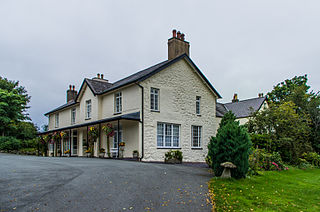
Dinas is a large hamlet near Bontnewydd, Caernarfon, in Gwynedd, north-west Wales.

The Afon Glaslyn is a river in Gwynedd, north-west Wales. While not of great significance in terms of its length, it is one of Gwynedd's primary rivers, and has greatly influenced the landscape in which it flows.
The Gorseddau Junction and Portmadoc Railway is a defunct Welsh tramway.

Cwmparc is a village and a district of the community of Treorchy, in the Rhondda Valley, Wales.
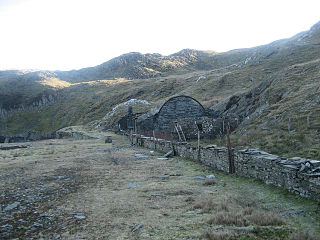
Croesor quarry is a large underground slate mine in North Wales which was served by Croesor Tramway. Small scale quarrying began in the 1846, and by 1861, there were two companies in operation. They amalgamated in 1865, a year after the quarry was connected to the newly opened Croesor Tramway. Much money was invested in development work, but volumes of useful slate produced were small, amounting to just 226 tons in 1868. Access to the underground workings was by a single adit, and the surface mill was powered by two water wheels. A change of ownership in 1875 did little to improve the profitability of the quarry, and it closed in 1878 or 1882.
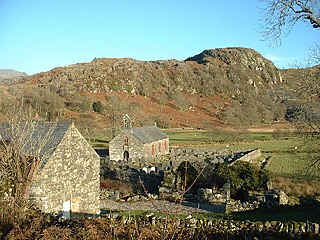
Llanfihangel-y-Pennant is a small village in Gwynedd, Wales. It is in the community of Dolbenmaen in Snowdonia.
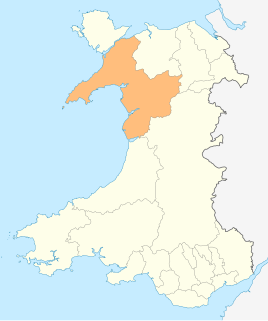
The River Rhythallt is a river in Gwynedd, North Wales whose source is Llyn Padarn. It flows in a northwesterly direction past the village of Brynrefail, Gwynedd and changes its name to Afon Seiont downstream of Pont Rhythallt in Llanrug. The Afon Seiont eventually reaches the sea at Caernarfon. The river has a broad flood plain which occasionally threatens homes in the village of Cwm-y-glo.

Parc Cwm long cairn, also known as Parc le Breos burial chamber, is a partly restored Neolithic chambered tomb, identified in 1937 as a Severn-Cotswold type of chambered long barrow. The cromlech, a megalithic burial chamber, was built around 5850 years before present (BP), during the early Neolithic. It is about seven 1⁄2 miles (12 km) west south–west of Swansea, Wales, in what is now known as Coed y Parc Cwm at Parc le Breos, on the Gower Peninsula.

Parc le Breos was a great medieval deer park in the south of the Gower Peninsula, about eight miles (13 km) west of Swansea, Wales, and about 1+1⁄4 miles (2.0 km) north of the Bristol Channel. The park was an enclosed, oval area of 6.7 miles (10.8 km) in circumference, covering about 2,000 acres (810 ha) and measuring 2+1⁄2 miles (east–west) by just over 1+3⁄4 miles. Parc le Breos was established in the 1220s CE by John de Braose, Marcher Lord of Gower and husband to Margaret Ferch Llywelyn, Llywelyn Fawr's daughter. Other than for deer husbandry, the park received an income from agistment, pannage, and from sales of wild honey, ferns and dead wood. There is evidence of rabbit warrens in the park. Whether the warrens were free or domestic is unknown.
Parc is the name of an ancient mansion found near the village of Croesor in the community of Llanfrothen near Penrhyndeudraeth, in Gwynedd, Wales. The former mansion has been in ruins since the end of the 17th century when the resident Anwyl Family moved to Llugwy.
"The older abode of the Anwyls, Parc, near Penrhyndeudraeth, although long neglected, has not altogether disappeared. It is approached by a drive of more than a mile in length. In front of the site of the house are four terraces, 150 feet long by 50 wide, supported by walls 12 feet high.
The part of the house still standing, built in 1671, is said to have been the ball-room. On the gable are curious large round chimneys. On either side of the front door are pieces of beautifully carved stone, formerly gilded, from the chimney-piece in the dining-hall; and one sees here and there, sometimes even in the walls of the present sheepfolds, mullions from the windows in freestone. At the back of the old mansion there are the ruins of a stone bath with seats round it and steps to descend. The "gate-house" (lodge) is still standing, but much dilapidated."

Llanfrothen is a hamlet and community in the county of Gwynedd, Wales, between the towns of Porthmadog and Blaenau Ffestiniog and is 108.1 miles (174.0 km) from Cardiff. In 2011 the population of Llanfrothen was 437 with 70.1% of them able to speak Welsh.
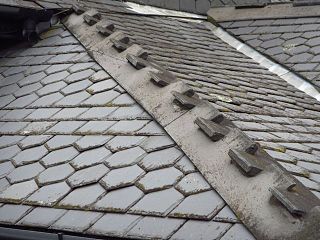
Parc Quarry was a compact underground slate quarry in the Croesor Valley, Gwynedd, North Wales. It was connected to the Croesor Tramway, which ran through the valley. The quarry concentrated on producing specialist slate products, rather than roofing slates, and was managed for much of the time by the innovator Moses Kellow. It operated for about 50 years, from 1870 to 1920.
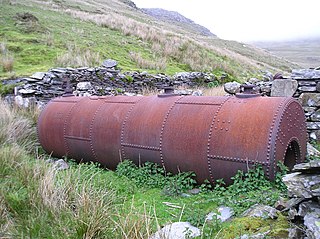
Fron-Boeth and Pant Mawr quarries were two closely related and interconnected quarries on the western slopes of Moelwyn Mawr in Gwynedd, North Wales. Pant Mawr operated from around 1850 to 1879, and was partly re-opened in 1886 when it was amalgamated with Fron-Boeth. Both quarries closed during the First World War. Finished product was transported to the slate quays of Porthmadog by the Croesor Tramway.
This page is based on this
Wikipedia article Text is available under the
CC BY-SA 4.0 license; additional terms may apply.
Images, videos and audio are available under their respective licenses.

















